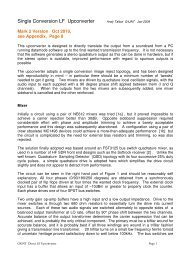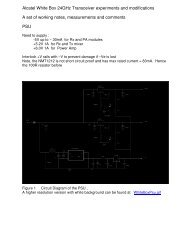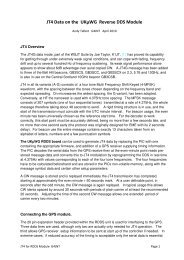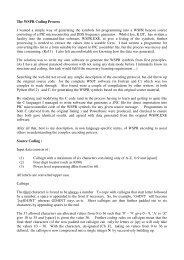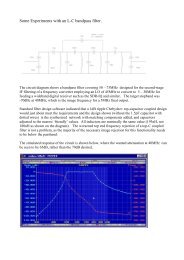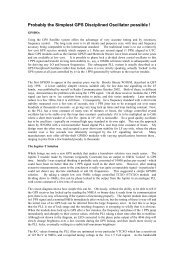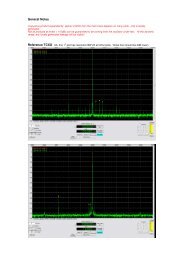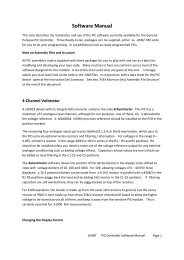G4JNT 144MHz direct conversion receiver with I/Q outputs for use ...
G4JNT 144MHz direct conversion receiver with I/Q outputs for use ...
G4JNT 144MHz direct conversion receiver with I/Q outputs for use ...
You also want an ePaper? Increase the reach of your titles
YUMPU automatically turns print PDFs into web optimized ePapers that Google loves.
and extra RF gain in transverters is catered <strong>for</strong> by backing off the audio gain. For signals too strong even<strong>for</strong> this (80db S/N in 20kHz) an external (calibrated) RF attenuator can be addedConstructionNo attempt was made to put this on a proper PCB. The converter and audio stages were built birds-neststyle on a piece of unetched copper clad PCB as can be seen in Photograph 1. Plenty of decoupling andshort <strong>direct</strong> wires ensure stable per<strong>for</strong>mance. As there is a lot of gain - particularly at audio - the wholeunit was built into a tinplate box <strong>for</strong> screeningUsing parallel and series 1% resistors <strong>for</strong> the switchable gain stage, no especial trimming or adjustment wasnecessary, the traces looked well enough matched on a 'scope and as I was only after 20 - 25dB sidebandrejection to make opposite sideband noise insignificant, tweaking wasn’t necessary. 3 degrees phase errorwill give 25dB rejection, assuming amplitude is correct, which is about equivalent to 5% amplitudeimbalance. So if I have a 'bit better' in each case the 20dB plus is easily achievable. All power rails areregulated and well filtered <strong>for</strong> operation off a portable 12V supply.The LO multiplier was made by cutting a 50 ohm microstrip line into a double sided PCB. To quicklymake a 50 ohm line <strong>with</strong>out etching, score two lines 2.8mm apart through the copper on the top face of thePCB <strong>for</strong> the full width, <strong>use</strong> a Stanley knife or similar making sure you penetrate the copper fully. 2.8mmwidth on normal 1.6mm thick fibreglass PBC gives about 50 ohms characteristic impedance. Then scoretwo more lines about 1mm from each of these. Using a hot soldering iron, <strong>use</strong> this to soften the adhesiveand <strong>with</strong> a pair of tweezers, lift up and remove the two 1mm wide strips, which will give a single 50 ohmline surrounded by copper groundplane. Drill a number of 0.8 to 1mm holes through the top ground planeto the underside and fit wire links to give a solid RF ground structure. Wire links are best fitted close towhere grounding and decoupling components are connected.Cut the 50 ohm line into segments <strong>with</strong> gaps <strong>for</strong> the modamps, DC blocking capacitors and filters. Otherconnections around the filters are made up birds nest style. When completed and aligned, coils can be heldin place <strong>with</strong> glue (a hot glue gun is a <strong>use</strong>ful accessory to have around) Photograph 2 shows thecompleted multiplier chain.Using the downconverter.For the standalone unit <strong>for</strong> <strong>use</strong> as a <strong>receiver</strong> in the field, a simple quadrature network and loudspeaker ampcan be added to make a complete <strong>receiver</strong>. A high/low pass pair of all pass networks will give 15dBsideband rejection over 400Hz to 2kHz which is good enough <strong>for</strong> listening to beacon signals on hill tops.Alternatively, look at Reference 2 <strong>for</strong> phasing type SSB networks to give an improved SSB per<strong>for</strong>mance.A meter driven from the audio level via a precision rectifier circuit can be added to allow quite precisesignal strength measurements to be made in conjunction <strong>with</strong> the calibrated attenuator. Alternatively, takeat look at the Software Defined Radio software (Ref 1) from I2PHD <strong>for</strong> another solutionLO SourceThe DDS module as described in Ref. 3 has new PIC software, along <strong>with</strong> a rotary encoder and LCDdisplay to give a <strong>use</strong>r friendly interface. For anyone who has the original DDS board I can supply PICsoftware <strong>for</strong> this modification. However, the AD9850 and ‘9851 chips are in short supply now - they havebeen replaced in most cases by larger, faster, new devices in a different package.Alternatively, emulate the venerable IC202 transceiver and build a VCXO to supply the signal to themultiplier. Or <strong>use</strong> a VFO/mixer, or a synthesizer - the choice is yours!



